Maslow’s Hierarchy – Critique Part One
I’ve been meditating on this all day. What is my problem with excuses? Why not just let a child off the hook if they have problems? Give them a break? Just understand that it is different for them because their home life is horrible and they just want to be safe and loved? If they aren’t fed and clothed then how can they be expected to behave? If they are witnessing abuse at home then how can we expect them to follow class rules?
It seems the main justification each time is that the child behaves poorly as a result of problems at home then they need to be able to express those negative emotions where they feel safe and we should understand that. We should also accept that the reasons for this and the fact that the child’s behaviour is unlikely to change while they are in the environment they are in. Instead, as teachers, we must look at our behaviour and see how we trigger the child’s emotions and act accordingly – the walking on egg shells approach.
Of course, the ‘there are excuses’ school are all about the emotion. Emotions before morality and spirituality is enshrined into Maslow’s hierarchy of needs.
This diagram that is widely used is not his visual representation of his ideas. It attaches weighting to the different needs that he doesn’t.
By FireflySixtySeven [CC BY-SA 4.0 (http://creativecommons.org/licenses/by-sa/4.0)], via Wikimedia Commons
The fact is that this is an equally valid visual representation of his ideas:
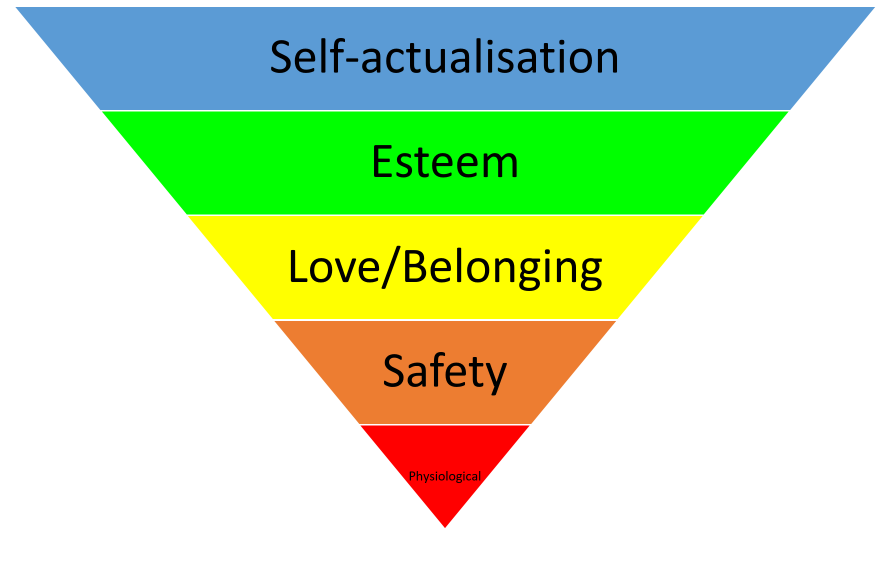
As is this:

As is this:
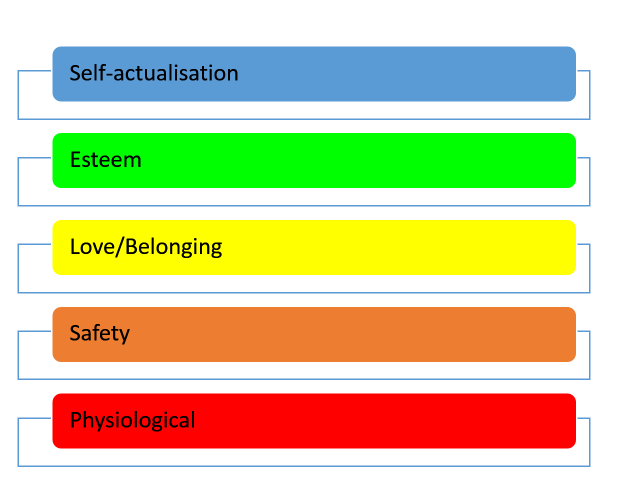
And this:

The red of the physiological does a great job of highlighting it’s importance – danger – needs attention, far more than the cool blue at the top. So what does it look like reversed?
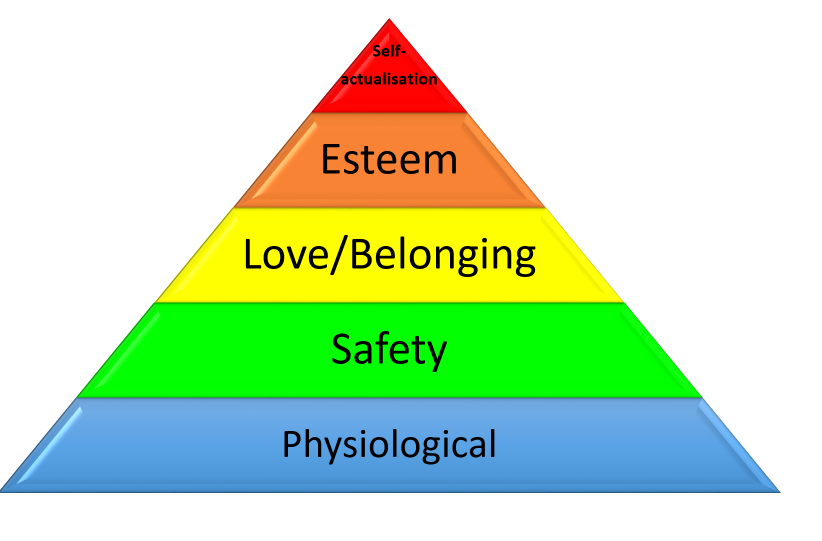
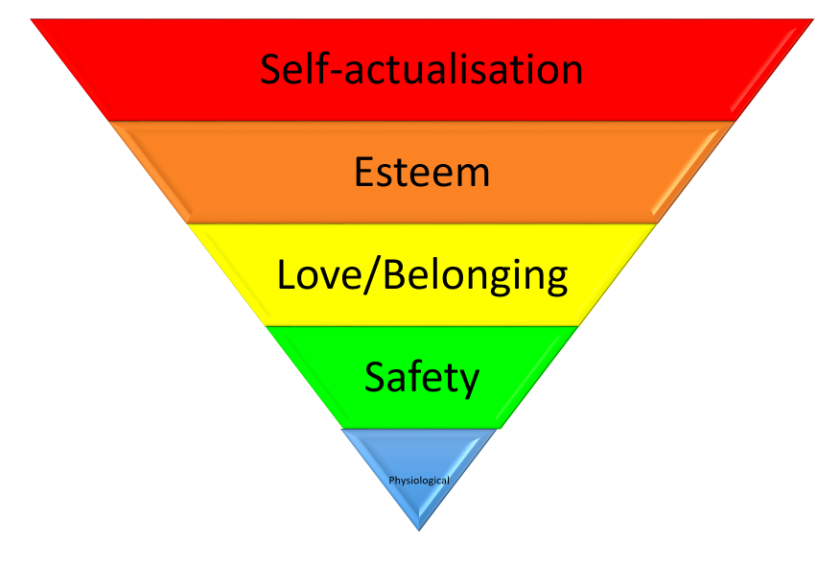
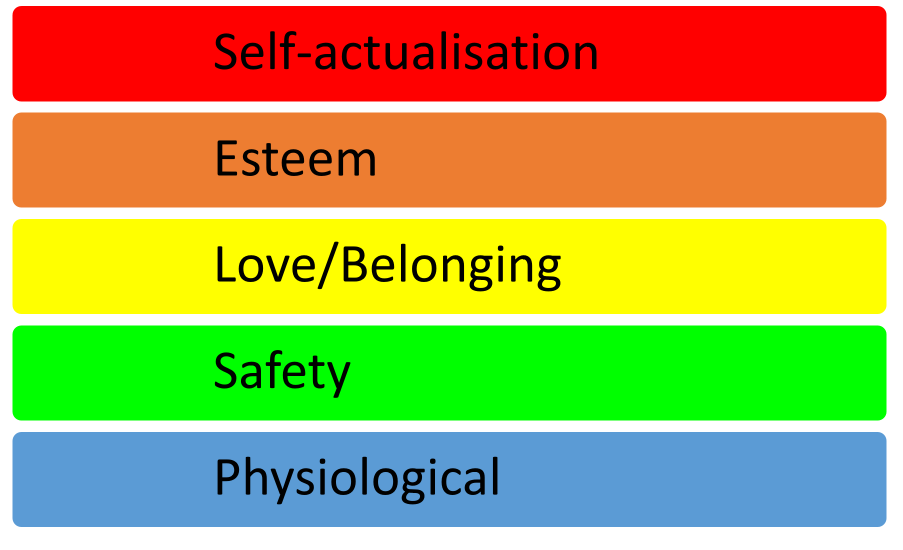
All these diagrams demonstrate how the organisation and presentation of ideas affect how we interpret them. The diagram directly above is nothing like the commonly used one, yet it is not wrong!!!
It is not Maslow I have the issue with here but those that have manipulated the visualisation of his ideas. We can all play that game so maybe we need to look at his ideas more honestly, in light of what he says, rather than a simplified diagram.



February 14, 2016 @ 11:29 am
Reblogged this on The Echo Chamber.
February 14, 2016 @ 1:01 pm
A fascinating post on a fascinating topic.
My perception is that you are coming across as a victim yourself, with all of these nasty people making you potentially suffer bad behaviour in the classroom in order to accomodate the whims of children.
You spend 2 paragraphs developing a completely ficticious context in which Maslow’s hierarchy has in some way something to do with this issue and for me this is fascinating. I have studied human motivation in great depth and Maslow’s hierarchy in particular. As a manager i did some masters research on the topic which illustrated clearly to me how the theory might and might not be applied in an educational context.
I am very much looking forward to part 2.
Your aray of diagrams was wonderous, the blockbusters thing is probably my favourite. I do tend to think that although Maslow didn’t use it, the common diagram is a good one to describe the theories.
To get hung up on the diagram is for me not good, but we find the same with Bloom’s taxononomy. People start to complain that knowledge is at the bottom as if that is a bad thing. I feel we are going the same way here.
Awaiting part 2
February 14, 2016 @ 1:50 pm
‘Fictitious’ is just a slightly less rude way of accusing someone of lying. Respond to the points if you disagree. There is nothing intelligent about sneaky, underhand negative comments.
http://www.bbc.co.uk/news/education-35431782 – this is just the latest of hundreds of surveys over the past few decades highlighting the increasing levels of verbal and physical abuse against teachers. It’s happening in classrooms and behaviour such as this is cited frequently by teachers who are unhappy in their roles as well as a reason for leaving teaching. The person being abused is the ‘victim’ of that situation. I think the people who believe excuses need to be made do care about the children involved and feel bad about their home lives. That has unfortunately led to accepting some ideas and theories uncritically, as well as the solutions that are based on those ideas.
As for your take on Maslow – a load of conjecture based on supposed readings. Ditto your understanding of human motivation.
No one knows me better than I know myself and the idea that you can based on a blog post is nonsense of the highest order. If you want to respond to the points made in the post – feel free to do so but I won’t be approving comments in future that are just sneaky attacks on my character based on the fact that we disagree. Same goes for paragraphs full of nothing except conjecture – e.g. Maslow’s diagram, application to the field of education.
The only thing I have learnt from your comment is that you value your own opinion very highly, which you are welcome to do so, but I don’t need to know about thanks.
February 16, 2016 @ 12:10 am
Maslow was keen to stress that self-transcendence and not self-actualisation was his later preferred apex. It’s also interesting to note how close his affiliation was with Esalen, the Mecca of the 1960s human potential movement where LSD was a common ‘sacrament’. I’m not so sure followers of Maslow in education would be so keen if their background knowledge was deeper than that damned triangle.
Maslow’s Hierarchy – Critique Part Two – Teachwell
February 18, 2016 @ 2:19 pm
[…] the first part of this post, I reviewed the link between Maslow’s hierarchy of needs and behaviour management systems in […]
Moving on from Maslow – Teachwell
February 22, 2016 @ 10:32 am
[…] first and second parts of this series of blogs explored the pyramid diagram and the critiquing the use of […]